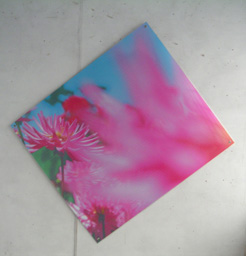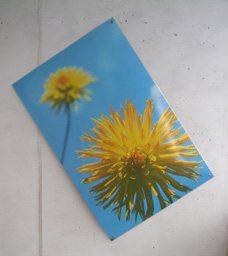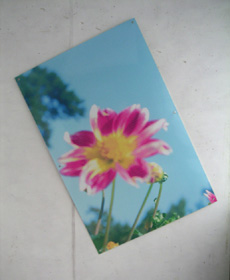 |
Contemporary
|
 |
Contemporary
|
Here, on a regular basis, we intend to show the works of major contemporary artists, most often whole series of prints from their most recent productions, with some general remarks as to their creation and their importance.
The present exhibition concerns a remarkable series of 35 large-format prints based on Ektachrome photographs shot by the artist, extensively retouched by the artist in Photoshop, and printed in very small editions of 6 impressions using digital technology on Kodak photographic paper.
Gary John Glaser (1951-2007) was an American graphic artist, born in Detroit, Michigan, raised in California, who studied at the University of California, Berkeley, and the Università degli Studi, Urbino, Italy. He lived and worked in Paris, France, from the early 1970s on.
He notably exhibited at the IXème Biennale de Paris (Palais de Tokyo, Paris, 1975), the Musée National d'Art Moderne (Centre Georges Pompidou, Paris, 1981, 1989, 1991), the Konsthall (Malmo, Sweden, 1984), the Centre nationale de la photographie (Palais de Tokyo, Paris, 1985), the Musée de la Poste (Paris, 1990), the Musée des Arts Décoratifs (Paris, 1994), the Château de Saint Ouen (Saint Ouen, 1998), the Musée d'Art Moderne de Saint Etienne (2002), with works in public collections (e.g., the Fonds National d'Art Contemporain), as well as numerous private shows in Parisian galleries; he also collaborated on various architectural projects, notably with Jean Nouvel, Dominique Lyon, and Jean-Philippe Pargade.
The artist describes his inspiration for the series:
This series began with my being aroused by the extravagant splendor of those horticultural creatures (competition dahlias) audaciously hybridized by hothouse Frankensteins, their apparent love of life shining out at me like an example, a generous burst of energy. Expressing this energy has become the basic subject of the series. Equally present, a touch of synthetic glamour betrays undeniable Southern Californian origins.
Digital definition efficiently relates the transcendental quality of the subject and liberates it from the morbid grip of photography. Filtered through purely technological processes (scanning, retouching on Photoshop, high-definition printing) photographed reality is dematerialized, made more perceptually digestible for the spirit. An omnipresent vibration passes from the light in the air to material matter and vice-versa, vibrating simultaneously in the two. To be in the moment, in witness of this confusion between matter and energy, can be a source of well-being.
The finishing of a digital print, turning it into an object, seeks to retain the freshness of a momentary vision. Plastic-film-laminated for lightness, cleanness, and flexibility, the piece is oriented obliquely to correspond to the intuitive angle of the original photograph. When hung, it is placed slightly above eye level and set away from the hanging surface to allow freedom to float or fly, an industrialized, daily reminder of the rarefied, joyful state to be attained in consciousness.
Estelle Pagès, art critic, has also written for us a short introduction to his work:
Refinement, preciosity, delicacy, subtlety, nuance, lightness, and sensuality express the range of possible qualities defining this photographic series, which Gary Glaser has been working on since 2000.
The dahlia (a flower inspiring such evocative names as Chambord, Joli Coeur, Firebird, Aramis, not to mention Arubanita) offers an abundant variety of composition, color, and form, that the artist seeks to grasp, to capture. Veritable source of observation, the dahlias give rise to a sort of visual declension, becoming the object of variations that open up new perspectives in the renewal and the transgression of reality
In Gary Glaser's work, a relation to the historiated genre of the "still life" may come to mind. Furthermore the photographic quality of the image, as rendered by ink-jet printing (which confers a specific velvety texture of diffused matter), induces questions of a purely pictorial nature.
Rendering the vibrancy of the image, capturing transparency and light, playing on the variations of color, focal depth and framing, allow the artist to engage in a reflection on the passage from the flower to the representation.
Softly blurred and finely textured, its colors reworked, the image thus produced confers an artificial quality on the flower, endowing it with a quivering breath of life. Gary Glaser extracts these flowers directly from nature, yet doesn't seek to render a naturalistic reality. On the contrary, these dahlias vibrate with life as a result of their metamorphosis, transformed and denatured by the phenomena specific to the technique employed and the dimensions of the image.
The format allows the viewer to "unframe" reality and the flower becomes more a motif than a subject, because it is not figured to scale. Its enlargement against a background that is most often monochrome tends to atomize the perception of the flower, transforming it into a pattern. In this set of photographic works, Gary Glaser thus raises the issue of the decorative and the kitsch aesthetic, which well consists of inventing something new and sensitive, while striving to reinterpret certain of our codes of representation.- Estelle Pagès (April, 2005)
35 digital prints, 2001-6,
a limited edition of 6 stamped and numbered impressions, printed
on wove Kodak photograph paper (250 gr/m2)
using an industrial ink-jet printer, in high definition (600 dpi),
with water-soluble GX ink, laminated in semi-rigid plastic film
(recto 80 microns, verso 250 microns) to ensure protection against
ultra-violet light and resistance to humidity and detergents,
and mounted with metal eyelets, so as to be hung at oblique angles,
away from the supporting wall. (Impressions are also available
without eyelets for those who so desire)
N.B. For practical reasons, and given the large size of these prints, we have decided to show them here in series, on a rather small scale, as hung in the artist's studio, with larger-scale images and occasonal close-ups accessible through the "view" icons.
 |
M18digital colour print 26/11/2001
P. 105 x 121 cm. *
* There also exists a wider version of this print. |
 |
J83digital colour print 17/12/2001
P. 79 x 120.5 cm. |
 |
M87digital colour print 18/01/2002
P. 103.5 x 155 cm. |
| 9 | M58 25-02-02 103X147 |
| 10 | J61 06-02-02 100,5X151 |
| 11 | J77 26-02-02 110X153 |
| 12 | M49 08-03-02 106X159 |
| 13 | J67 09-04-02 102X151 |
| 15 | M89 24-10-02 126X180,5 |
| 16 | R213 28-11-02 108X150,5 |
| 17 | C44 03-12-02 87,5X131 |
| 18 | R228 19-12-02 102X151 |
| 19 | V183 25-01-03 110,5X151 |
| 20 | N4 06-02-03 101X152 |
| 21 | V213 27-02-03 102X151 |
| 22 | M74 27-03-03 117X173 |
| 23 | C9 8-04-03 117,5X173,5 |
| 24 | J32 12-09-03 96X141 |
| 25 | M58 24-10-02 103X147 |
| 26 | M51 21-11-03 121X168 |
| 27 | V191 04-12-03 126X162 |
| 28 | M85 17-03-04 103X153,5 |
| 29 | C31 31-03-04 101,5X150,5 |
| 30 | M81 13-02-04 101X135 |
| 31 | M71 15-07-04 96X134 |
| 32 | J62 21-04-04 126X149,5 |
| 33 | J84 05-05-04 125X184,5 |
| 34 | C24 03-11-04 114X141,5 |
| 35 | M47 29-11-04 121X179,5 |
| 36 | J12 09-12-04 108X150 |
| This Website page is currently under construction. Please bear with us, and we beg your pardon for any inconvenience... | |
| to view the full catalogue, please click here |